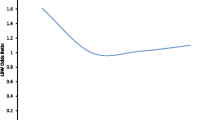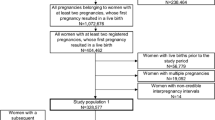Abstract
Pregnancy termination intervals, i.e., live birth to live birth (LB-LB), live birth to fetal loss (LB-FL), and fetal loss to live birth (FL-LB), are analyzed prospectively between 1966 and 1970 in a rural population (117,000) of Bangladesh. Results indicate that the mean LB-LB interval was almost 30 months, the LB-FL interval 27 months, and the FL-LB interval 18 months. In addition, postpartum amenorrhea was estimated to be about 13-14 months, and the time added by a fetal loss toa LB-LB interval about 15 months. No relationship was found between LB-LB intervals and the number of living or dead children.
Similar content being viewed by others
References
Baxi, P. G. 1957. A Natural History of Childbearing in the Hospital Class of Women in Bombay. Journal of Obstetrics and Gynaecology of India September: 26–51.
Chen, Lincoln C., S. Ahmed, M. Gesche, and W. N. Mosley. 1973. A Prospective Study of Birth Interval Dynamics in Rural Bangladesh. Unpublished mimeographed paper. Baltimore: Department of Population Dynamics, Johns Hopkins University,
Chopra, P. L. 1965. A Study at the Male Family Planning Clinic Jabalpur (Observations and Suggestions). Journal of Family Welfare (Bombay) 11:19–26.
Dandekar, Kumudini. 1963. Analysis of Birth Intervals of a Set of Indian Women. Eugenics Quarterly 10:73–78.
—. 1959. Intervals between Confinements. Eugenics Quarterly 6: 180–186.
Das, Amal K, and Swapan K Banerjee. 1964. Certain Aspects of Population Growth Amongst the Tribals of West Bengal. Bulletin of the Cultural Research Institute (Calcutta) 3:1–14.
Day, Lincoln H. 1965. Differentials in Age of Women at Completion of Childbearing in Australia. Population Studies 18:251–264.
Freedman, Ronald. 1963. The Sociology of Human Fertility: A Trend Report and Bibliography. Oxford, England: Basil Blackwell.
Leridon, Henri. 1967. Les Intervalles Entre Naissances: Nouvelles Donnees d’Observation. Population: Revue Bimestrielle 22:821–840.
Potter, Robert G., Jr. 1963. Birth Intervals: Structure and Change. Population Studies 17:155–166.
—, and M. P. Parker. 1964. Predicting the Time Required to Conceive. Population Studies 18:99–116.
—, John B. Wyon, Margaret Parker and John E. Gordon. 1965. A Case Study of Birth Interval Dynamics. Population Studies 19: 81–96.
—, Charles F. Westoff, and Philip C. Sagi, 1963. Delays in Conception: A Discrepancy Re-examined. Eugenics Quarterly 10:53–58.
Ranganathan, H. N. 1965. Recent Trends in Birth Order Statistics of Poona City. Population Review (Madras) 9:82–85.
Sheps, Mindel C. 1966. Applications of Probability Models to the Study of Patterns of Human Reproduction. In Mindel C. Sheps and Jeanne C. Ridley (eds.), Public Health and Population Change: Current Research Issues. Pittsburgh: University of Pittsburgh Press.
—. 1965. An Analysis of Reproductive Patterns in an American Isolate. Population Studies 19:65–80.
Song, Yong Kun. 1966. An Analysis of Birth Intervals and Their Effect on Fertility in Korea. Journal of Population Studies (Seoul) 2:106–127.
Stewart, Alice, and Barbara Renate. 1963. Data on Parental Age, Sibship Size and Twins. Annals of Human Genetics 27:1–9.
Stoeckel, John, and A. K M. Choudhury. 1973. Fertility, Infant Mortality and Family Planning in Rural Bangladesh. Oxford, England: Oxford University Press.
—, and A. K M. Choudhury. 1972. The Effect of Fecundity on Fertility in Rural East Pakistan (Bangladesh). Social Biology 19: 193–201.
Taiwar, P. P. 1965. A Note on the “Test of Significance of Intervals between Confinements of Different Birth Orders.” Eugenics Quarterly 12:251–253.
Tietze, Christopher. 1963. The Effect of Breastfeeding on the Rate of Conception. Vol. II pp. 129–136 in the Proceedings of the International Population Conference, New York, 1961.
Wolfers, D. 1968. Determinants of Birth Intervals and Their Means. Population Studies 22:253–262.
Yang, Jae Mo, Sook Bang, Myung Ho Kim, and Man Gap Lee. 1965. Fertility and Family Planning in Rural Korea. Population Studies 18:237–250.
Author information
Authors and Affiliations
Rights and permissions
About this article
Cite this article
Stoeckel, J., Choudhury, A.K.M.A. Pregnancy termination intervals in a rural area of Bangladesh. Demography 11, 207–214 (1974). https://doi.org/10.2307/2060559
Issue Date:
DOI: https://doi.org/10.2307/2060559




